What is the name for Mg(HSO 4 ) 2 ?
- Magnesium(II) sulfate
- Magnesium bisulfite
- Magnesium hydrogen sulfate
- Magnesium sulfuride
Magnesium hydrogen sulfate
Ex.
The correct name for Mg(HSO 4 ) 2 is magnesium hydrogen sulfate or magnesium bisulfate.
Magnesium sulfate would have the formula MgSO 4 , and a Roman numeral is not needed since magnesium is an alkaline earth metal and has only one possible charge.
Magnesium bisulfite, also known as magnesium hydrogen sulfite, would have the formula Mg(HSO 3 ) 2 .
Sulfuride is not the name for an ion.
What is the formula for chromium(II) hydroxide?
- Cr2OH
- Cr(OH)2
- CrOH
- CrO2H2
Cr(OH) 2
Ex.
Chromium(II) hydroxide has the formula Cr(OH) 2 . Chromium has a 2+ charge and the hydroxide ion has a 1- charge, so two anions are needed to balance the charge of the cation.
CrOH and Cr 2 OH do not have the correct ratios to balance the charges between the cations and anions.
CrO 2 H 2 has the correct number of each element, but the formula does not indicate that the hydroxide ion acts as a group and needs to be shown as (OH) in the formula.
What is the name for the compound with the formula PbF 2 ?
- Lead(II) fluoride
- Lead(I) fluoride
- Lead(IV) fluoride
- Lead fluoride
Lead(II) fluoride
Ex.
The name for the compound with the formula PbF 2 is lead(II) fluoride . Lead cations can have more than one charge (2+ or 4+), so a Roman numeral should be included in the name. Fluoride has a 1- charge and if two anions are needed to balance the charge on the lead cation, then it must have a 2+ charge.
Lead(IV) fluoride would have the formula PbF 4 .
What is the name for the compound with the formula NCl 3 ?
- Trichlorine nitride
- Nitrogen chloride
- Nitrogen trichloride
- Mononitrogen trichloride
Nitrogen trichloride
Ex.
The name for NCl 3 is nitrogen trichloride . No prefix is needed for nitrogen because there is only one nitrogen atom. The prefix tri– is used for chlorine to indicate that there are three chlorine atoms in the formula.
There is only one atom of nitrogen so a prefix is not needed for nitrogen as shown in mononitrogen trichloride.
Nitrogen chloride needs a prefix for chlorine to indicate the number of atoms of that element.
Trichlorine mononitride does not place the elements in the same order as they are given in the formula.
What is the name for NH 4 + ?
- Nitrite
- Ammonium ion
- Nitrate ion
- Ammonia
Ammonium ion
Ex.
The formula for ammonium is NH 4 + , while ammonia is the neutral compound NH 3 .
Nitrate and nitrite are NO 3 — and NO 2 — , respectively.
Which one of the pairs correctly matches the ion’s name with its formula?
- Sulfate, SO32–
- Carbonate, CO32–
- Chlorate, ClO4—
- Nitrate, NO2—
Carbonate, CO 3 2–
Ex.
The formula for the carbonate ion is CO 3 2– .
Nitrate (NO 3 — ), sulfate (SO 4 2– ), and chlorate (ClO 3 — ) are not paired with the correct formula. NO 2 — is the formula for nitrite; SO 3 2– is the formula for sulfite; and ClO 4 — is the formula for perchlorate.
The common name for B 2 H 6 is diborane. What is the IUPAC name for B 2 H 6 ?
- Triboron heptahydride
- Diboron hexahydride
- Triboron hexahydride
- Diboron heptahydride
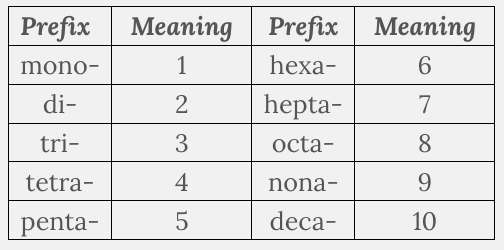
Diboron hexahydride
Ex.
The name for B 2 H 6 is diboron hexahydride . The prefix di– is used to indicate the two atoms of boron, and hexa– indicates the six atoms of hydrogen. The formula for diboron heptahydride is B 2 H 7 . The prefix tri– , used in triboron hexhydride (B 3 H 6 ) and triboron heptahydride (B 3 H 7 ) indicates three atoms of boron which does not match the given formula.
What is the name for the compound with the formula FeO?
- Iron oxide
- Iron(III) oxide
- Iron(I) oxide
- Iron(II) oxide
Iron(II) oxide
Ex.
Iron(II) oxide is the name for the compound with the formula FeO. Since iron is a transition metal and can have multiple charges (2+ and 3+), the Roman numeral is needed to indicate its charge. The formula has a 1:1 ratio between the cation and anion, so the charge on the iron must be the same magnitude but the opposite sign for the oxide anion (2-).
Iron oxide is incorrect because it does not include the Roman numeral, while iron(I) oxide and iron(III) oxide do not have the correct charge for iron in parentheses.
What is the formula for the aqueous solution with the name hydrosulfuric acid?
- H2S(aq)
- H3SO4(aq)
- H2SO4(aq)
- HS(aq)
H 2 S(aq)
Ex.
The formula for hydrosulfuric acid is H 2 S when the substance is found in the aqueous phase.
The name for H 2 SO 4 is sulfuric acid.
Neither H 3 SO 4 nor HS exist because they cannot have a stable structure. Therefore, they do not have systematic names.
What is the formula for sulfurous acid?
- H2S(aq)
- H2SO3(aq)
- H2SO4(aq)
- HSO3(aq)
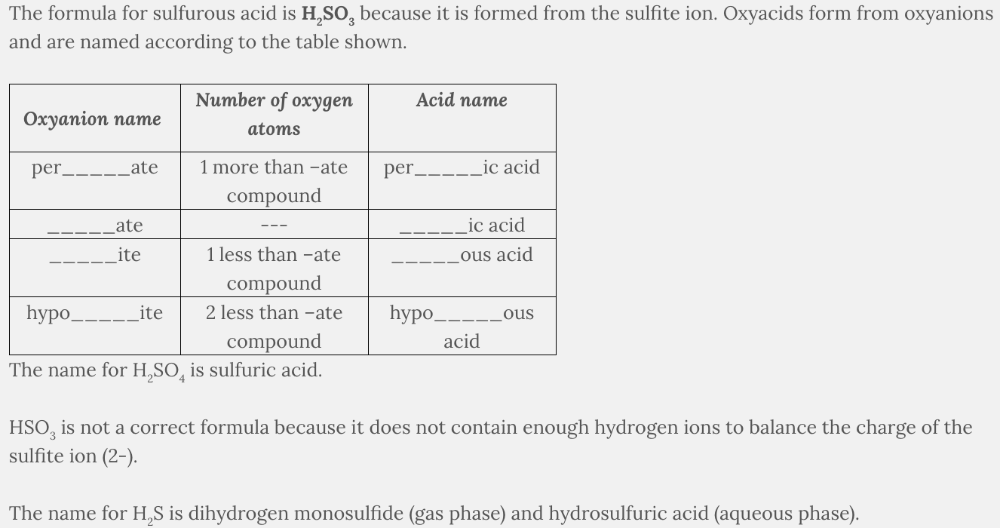
H 2 SO 3(aq)
An ionic compound has the formula X 2 O. Identify the element, X.
- Potassium
- Calcium
- Hydrogen
- Sulfur
Potassium
Ex.
Potassium can be the cation in the ionic compound X 2 O. To balance the 2- charge of the oxygen, two of the unknown cation should have a 2+ charge. This means that each cation should have a 1+ charge. Of the options given, potassium and hydrogen have 1+ charges. However, H 2 O is a covalent compound.
Calcium forms a cation with a 2+ charge and sulfur forms an anion with a 2- charge so neither can be X.
Which one of the following correctly pairs the element and the charge it forms in an ionic compound?
- Li, 1+
- Mg, 2-
- Cl, 1+
- O, 3-
Li, 1+
Ex.
Lithium forms an ion with a 1+ charge because it donates one electron to the element forming the anion in the compound.
Magnesium is a metal and forms a 2+ charge.
Oxygen accepts two electrons in an ionic compound and forms a 2- charge. Chlorine accepts one electron to form an ion with a 1- charge.
What formula represents the compound formed from aluminum and hydroxide?
- Al3(OH)2
- Al(OH)3
- Al2(OH)3
- AlOH
Al(OH) 3
Ex.
The formula for aluminum hydroxide is Al(OH) 3 . Aluminum has a 3+ charge, and hydroxide has the formula OH — . Therefore, three hydroxide ions, each with a 1- charge, are needed to balance the 3+ charge for the aluminum.
Al 2 (OH) 3 , AlOH, and Al 3 (OH) 2 do not balance the charges between the cation and anion.
Which ionic compound formulation is most likely as predicted by the elements' positions in the periodic table?
- K2O
- LiN3
- SrS2
- CaCl
K 2 O
Ex.
Potassium oxide has the formula K 2 O because potassium has a 1+ charge and two potassium ions are needed to balance the 2- charge of the oxide ion.
Strontium (2+) and sulfur (2-) would form SrS rather than SrS 2 .
Li 3 N is the compound formed from lithium (1+) and nitrogen (3-), while calcium (2+) and chlorine (1-) will form CaCl 2 . The ratios between the cation and anion in ionic compounds must be such to balance the charge between the two ions.
What is the formula for tetraphosphorus nonasulfide?
- P3S8
- P4S10
- P3S9
- P4S9

P 4 S 9
Ex.
The formula for tetraphosphorus nonasulfide is P 4 S 9 . Tetraphosphorus indicates that there are four atoms of phosphorus, and nonasulfide represents the nine atoms of sulfur.
The names for P 3 S 8 , P 4 S 10 , and P 3 S 9 are triphosphorus octasulfide, tetraphosphorus decasulfide, and triphosphorus nonasulfide, respectively.
What are the charges on the copper and phosphide ions, respectively, in copper(II) phosphide?
- 2-, 3+
- 2-, 1+
- 2+, 1-
- 2+, 3-
2+, 3-
Ex.
In copper(II) phosphide, the copper ion has a 2+ charge and the phosphide ion has a 3- charge. The cation is listed first in the name for the compound so the copper must have a positive charge. The Roman numeral listed after copper indicates that the copper will have a 2+ charge.
Phosphide written second, indicating that it is the anion, has a 3- charge.
What is the name for the compound with the formula As 2 O 5 ?
- Argon pentoxide
- Arsenic pentoxide
- Diarsenic pentoxide
- Diargon pentoxide

Diarsenic pentoxide
Ex.
The name for As 2 O 5 is diarsenic pentoxide . The chemical symbol for arsenic is “As,” and since there are two arsenic atoms, the di– prefix must be used. The five oxygens in the formula are indicated by the penta– prefix. However, the a is dropped from the prefix to eliminate a double vowel in the name. The symbol for argon is “Ar”, and as a noble gas, it does not form covalent compounds.
What is the formula for acetic acid?
- HCOOH(aq)
- COOH(aq)
- CH3COOH(aq)
- CH3OH(aq)
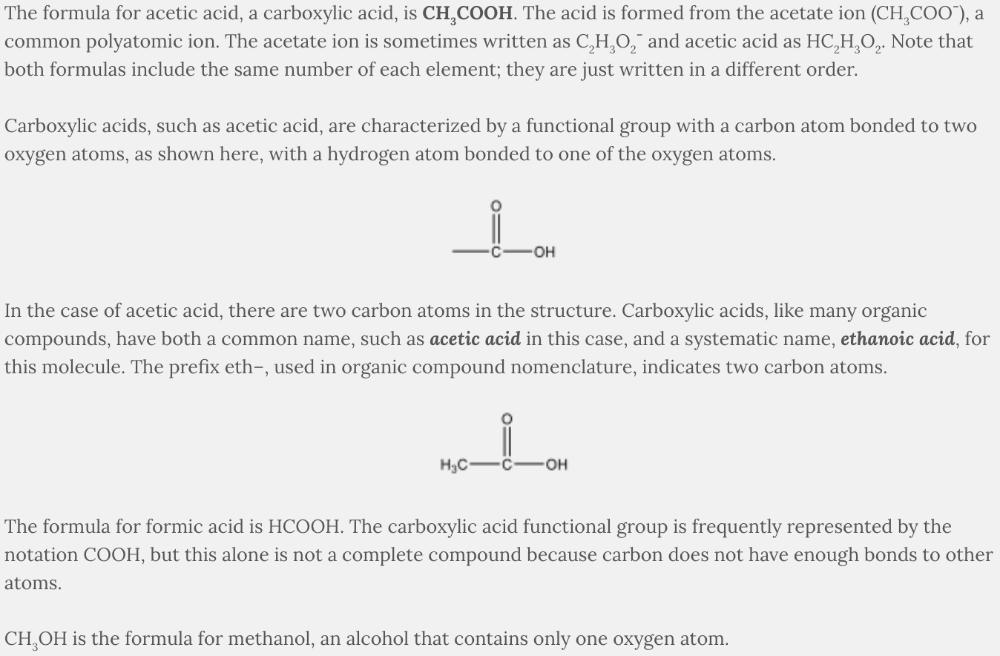
CH 3 COOH(aq)
What is the name for the ion with the formula ClO 2 — ?
- Chlorate ion
- Perchlorate ion
- Chlorite ion
- Hypochlorite ion
Chlorite ion
Ex.
ClO 2 — is the formula for chlorite .
Perchlorate, chlorate, and hypochlorite are ClO 4 — , ClO 3 — , and ClO — , respectively.
What is the name for the compound with the formula CoP?
- Cobalt phosphate
- Cobalt(III) phosphate
- Cobalt(III) phosphide
- Cobalt phosphide
Cobalt(III) phosphide
Ex.
The name for the compound with the formula CoP is cobalt(III) phosphide . Cobalt has two possible charges, 2+ and 3+, so a Roman numeral should be included in the name to represent the charge of the cation in this compound.
Cobalt(III) phosphate would have the formula CoPO 4 .
What is the formula for phosphorus pentabromide?
- PBr5
- PBr4
- P5Br
- PBr6

PBr 5
Ex.
The formula for phosphorus pentabromide is PBr 5 . Phosphorus is the first element and does not have a prefix, which indicates that there is only one phosphorus atom in the formula. Pentabromide indicates that there are five bromine atoms in the formula.
The names for PBr 6 , PBr 4 , and P 5 Br are phosphorus hexabromide, phosphorus tetrabromide, and pentaphosphorus monobromide, respectively.
What is the name for the compound with the formula RbF?
- Rubidium fluorine
- Fluorine rubidide
- Fluorine rubidium
- Rubidium fluoride
Rubidium fluoride
Ex.
Rubidium fluoride is the name for the ionic compound with RbF. For ionic compounds, the cation name is the same name as the element and is written first. The anion is named second and is the name of the element with the ending changed to “ide.”
What is the name for the acid formed in aqueous solution with the formula HClO 3 (aq)?
- Perchloric acid
- Hypochlorous acid
- Chloric acid
- Chlorous acid
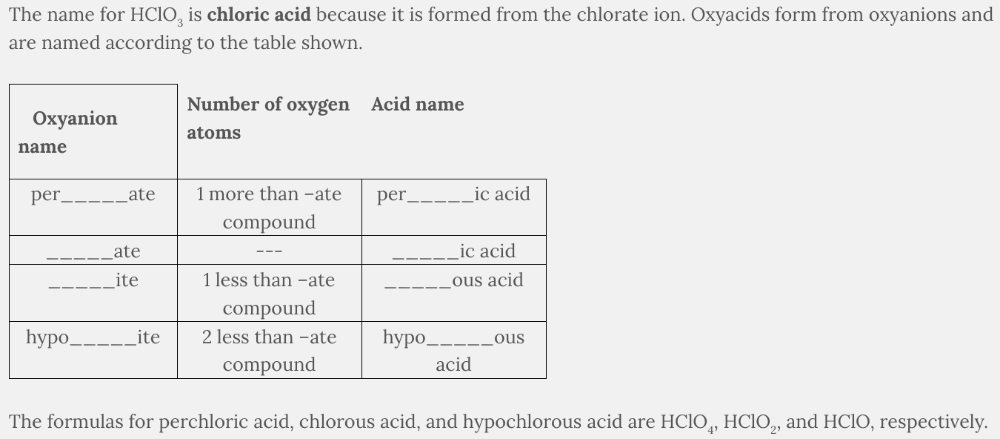
Chloric acid
What are the values of x and y in the compound Na x (CrO 4 ) y ?
- x = 3, y = 2
- x = 2, y = 1
- x = 1, y = 2
- x = 3, y = 1
x = 2, y = 1
Ex.
For the compound Na x (CrO 4 ) y , x = 2 and y = 1 giving the formula Na 2 CrO 4 which is named sodium chromate . Two sodium ions (each with a 1+ charge) are needed to balance the 2- charge for the chromate ion.
What formula represents the compound formed from ammonium and phosphate ions?
- NH4PO4
- N3H12PO4
- NH4(PO4)3
- (NH4)3PO4
(NH 4 ) 3 PO 4
Ex.
(NH 4 ) 3 PO 4 is the formula for the compound formed from the ammonium (NH 4 ᐩ) and phosphate (PO 4 3– ) ions. Since ammonium has a 1+ charge, three are needed to balance the 3- charge of the phosphate ions.
NH 4 PO 4 and NH 4 (PO 4 ) 3 do not form because they do not balance the charges between the ions. N 3 H 12 PO 4 has the correct number of each atom, but polyatomic ions function as a group, so we need to show the formula as having three NH 4 + ions. We do this by placing the ion in parentheses, since there is more than one.
Which pair of ions will readily form an ionic compound with a 1:1 ratio?
- Barium and chlorine
- Aluminum and fluorine
- Sodium and phosphorus
- Calcium and sulfur
Calcium and sulfur
Ex .
Calcium and sulfur will form an ionic compound with a 1:1 ratio since they have 2+ and 2- charges, respectively. To form an ionic compound, the cation charge must balance the anion charge.
Barium and chlorine will form BaCl 2 .
Aluminum and fluorine will from AlF 3 .
Sodium and phosphorus will form Na 3 P.
What is the name for the compound with the formula SnSO 4 ?
- Tin(II) sulfate
- Tin(IV) sulfate
- Tin sulfate
- Tin(I) sulfate
Tin(II) sulfate
Ex.
The name for the compound with the formula SnSO 4 is tin(II) sulfate . Sulfate has a 2- charge. The magnitude of the charge on tin must match that of sulfate since the formula includes one tin ion and one sulfate ion. Tin has two possible charges, 2+ and 4+, so a Roman numeral must be used in the name to indicate which one.
Tin(IV) sulfate has the formula Sn(SO 4 ) 2 , and tin(I) sulfate does not exist.
Which one of the following correctly pairs a formula with its name?
- Zn(NO3)2, zinc(II) nitride
- ZnCr2O7, zinc dichromate
- Zn2O, zinc(II) oxide
- ZnCl, zinc chloride
ZnCr 2 O 7 , zinc dichromate
Ex.
Zinc dichromate has the formula ZnCr 2 O 7 .
Zinc chloride would have the formula ZnCl 2 . Zinc has only one possible charge (2+), so Roman numerals are not needed in the name for zinc compounds.
Zn(NO 3 ) 2 has the name zinc nitrate and ZnO is zinc oxide.
Zinc nitride has the formula Zn 3 N 2 .
Stories about the dangers of dihydrogen monoxide circulate occasionally online, and peoplecall for it to be banned. What is the formula for this compound?
- (HO)2
- HO2
- O2H
- H2O
H 2 O
Ex.
The formula for dihydrogen monoxide is H 2 O , commonly known as “water.” Dihydrogen indicates that there are two hydrogen atoms, and monoxide indicates that there is one oxygen atom. While the statements in the story are true, the message is very misleading.
The name for HO 2 , if it existed, would be hydrogen dioxide.
(HO) 2 is not a valid formula for a covalent compound; parentheses are not used as they are for polyatomic ions.
The name for O 2 H is dioxygen monohydride which is also a nonexistent compound.
What is the formula for mercury(II) nitride?
- HgNO3
- Hg(NO3)2
- Hg2N
- Hg3N2
Hg 3 N 2
Ex.
The formula for mercury(II) nitride is Hg 3 N 2 . Mercury has a 2+ charge, as indicated by the Roman numeral, and nitride has a 3- charge. Three mercury ions and two nitride ions are needed to balance the charges between the cation and anion.
Hg(NO 3 ) 2 is mercury(II) nitrate.
Neither Hg 2 N nor HgNO 3 have the correct ratio of ions to balance the charges between the cation and anion.
What is the formula for the ionic compound predicted to form from beryllium and bromine based on their positions in the periodic table?
- BeBr2
- Be2Br
- BeBr
- Be2Br2
BeBr 2
Ex.
The formula for the compound made from beryllium and bromine is BeBr 2 .
Beryllium has a 2+ charge, and bromine has a 1- charge, so two bromine ions are needed to balance the charge of one beryllium ion.
BeBr, Be 2 Br, and Be 2 Br 2 do not have the correct ratio of atoms to balance the charge between the two ions.
Which group contains only elements that can form anions in ionic compounds?
- Chlorine, strontium, and phosphorus
- Copper, selenium, and bromine
- Calcium, lithium, and barium
- Nitrogen, oxygen, and fluorine
Nitrogen, oxygen, and fluorine
Ex.
Nitrogen, oxygen, and fluorine will all form anions in ionic compounds. Metals form cations, and nonmetals form anions in ionic compounds.
Selenium, bromine, chlorine, and phosphorus are nonmetals and will all form anions in ionic compounds. Calcium, lithium, barium, copper, and strontium are metals and will form cations in ionic compounds.
One of the by-products from internal combustion engines, where gasoline is burned in air, is nitrogen dioxide. As the exhaust of the engine passes through a catalytic converter, nitrogen and oxygen gases are re-formed. Which equation best represents the balanced reaction for this process?
- 2 NO2(g) → N2(g) + 2 O2(g)
- NO(g) → N(g) + O(g)
- NO2(g) → N(g) + O2(g)
- N2O(g) → NO(g) + N(g)
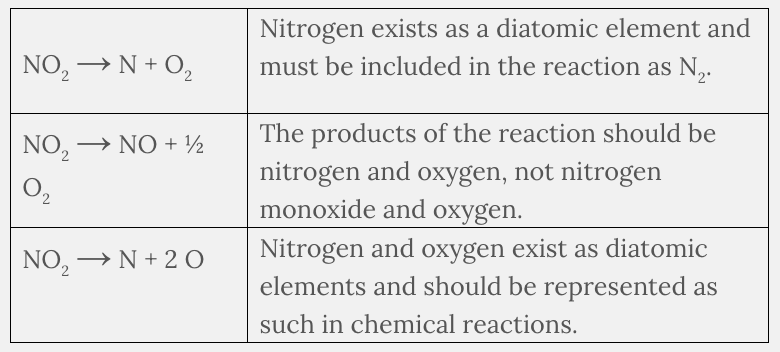
2 NO 2 (g) → N 2(g) + 2 O 2(g)
Ex.
The balanced reaction for the decomposition of NO 2 is 2 NO 2 → N 2 + 2 O 2 . The formula for nitrogen dioxide is NO 2 and both nitrogen and oxygen exist as diatomic elements.
What is the charge on the silver ion in AgMnO 4 ?
- 1+
- 1-
- 2-
- 2+
1+
Ex.
The charge on the silver ion in AgMnO 4 is 1+ because it has only one possible charge, 1+. The permanganate ion, MnO 4 ¯, has a 1- charge, so a compound with a 1:1 ratio will have the same magnitude of charge on both ions. The cation is written first in the formula and in the name.
Identify the formula for chromic acid formed in aqueous solution.
- H2CrO3(aq)
- H2CrO4(aq)
- HCrO4(aq)
- H2Cr2O7(aq)
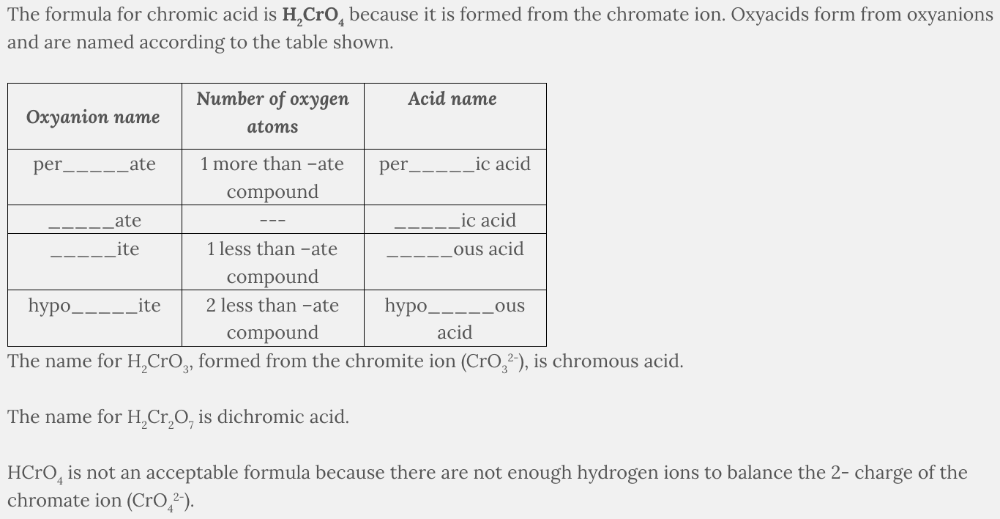
H 2 CrO 4(aq)